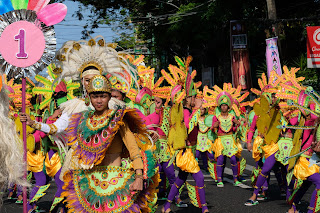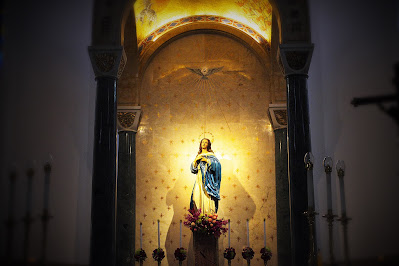“My soul magnifies the Lord
And my spirit rejoices in God my Savior;
Because He has regarded the lowliness of His handmade;
For behold, henceforth all generations shall call me blessed;
Because He who is mighty has done great things for me,
and holy is His name…”
- Luke 1:46-55
“Woman, behold your son. Son, behold your mother”
- John 19:26-27
Though the modern canon of scripture does not record Mary's birth, September 8 is traditionally celebrated as the feast of the solemnity of the Nativity of the Blessed Virgin Mary.
According to old traditions Mary was born in Jerusalem. Joachim is said to have been the owner of a home in the vicinity of the temple, more precisely near the Sheep Gate and its pool called in Hebrew Bethesda. A grotto nearby is believed to be the place where Mary was born.
The Philippines is known as “El Pueblo Amante De Maria” or the town in love with Mary. The Blessed Virgin Mary, La Gran Madre de Dios, to whose immaculate heart the entire Philippines was consecrated. Mary, is known in many names and titles.
On July 16, 1935, Our Lady of Guadalupe was declared by Pope Pius XI as the secondary patron saint of the Philippines, the tradition probably originated because of the ties of Spanish Manila with Mexico, another Spanish colony. However on September 12, 1942, a Papal Bull was by Pope Pius XII declaring that the Immaculate Conception is the principal and universal patroness of the Philippines.
The country had been united with Mary from the time the Philippines was Christianized by the Spaniards. We all love the woman that Jesus gave us on the cross to be our own mother, and to her we seek maternal protection.
But many protestant or fundamentalist sects look down on Mary as if Jesus had become the “Word that became flesh that dwelt amongst us (John 1:14)” without Mary. To deny Mary is to deny the divinity of Jesus, that our redemption would not be possible at the right moment if Mary did not say “Fiat”.
The protestant churches accuse Catholics of worshipping Mary and other Saints and look at it as idolatry. But we do not worship Mary but only honor her as the earthly mother of Jesus and her role in man’s redemption.
Non-Catholics may have rejected Mary but paradoxically non-purist Muslims do honor Mary. The Blessed Virgin Mary, Mariam in Arabic, has a very exalted place in Muslim belief as the birth of Mary is found in the Quran, and the entire 19th Chapter of the Quran is named specifically after her (“A Muslim for Mary”, Washington Post, December 9, 2010).
Mary, the mother of Isa (Jesus) is to Muslims, as she is to most Christians, “the greatest woman who ever lived, one who never sinned, conceived herself without sin, a virgin impregnated by God, who was assumed into heaven after her earthly life. August 15, the Catholic feast of the Assumption of Mary into heaven is holy also to Muslims for the same reason, and is therefore a national holiday in Lebanon (Muslim Mary and the Hope for Islam’s Conversion, the Christians.com).”
“The Quran names no woman except Mary, and says about her than the bible does, much of it taken from the apocryphal Gospel of James (ibid)”.
“A woman of the house of Imran (Joachem) prayed: ‘O my sustainer! Behold. Unto Thee do I bow (the child) that is in my womb to be devoted to Thy service. Accept it, then, from me: ‘O my sustainer! Behold, I have given birth to a female… and I have named her Mary, and verily, I seek Thy protection for her and her offspring against Satan, the accursed (3:35-36).”
In the Philippines, particularly in Zamboanga City in Mindanao, the Blessed Virgin Mary under the title Nuestra Señora del Pilar (Our Lady of the Pillar) is venerated both by Muslims and Christians.
In fact, it was a Muslim friend who took me to the outdoor shrine of Our Lady of the Pillar in Fort del Pilar (formerly known as Real Fuerza de San Jose) for the afternoon mass. I attended the daily mass there during my entire stay in Zamboanga a few years back.
The veneration of Mary by Muslims in Zamboanga is not only anchored in the Quran but from their own experience of Mary’s maternal protection.
Legend has it that she was the same Lady seen by many “standing in mid-air over Basilan Strait on September 21, 1897, with her right hand raised to signal the onrushing waves to stop, saving Zamboanga City from a tsunami (Josephine Darang, “Muslims and Christians Venerate Our Lady of the Pillar, Philippine Daily Inquirer).”
I first heard this story from my aunt many, many years ago.
So many children, both males and females, have been named Maria or their names preceded by Maria. Similarly, so many towns have Mary in her many titles as their patroness. “The oldest Marian icon dating back to 1571, later known as Nuestra Senora de Guia (Our Lady of Guidance), now venerated in Ermita church in Manila (Jose Maria Antonio “Anton” Quintos Luat).”
The second oldest icon is that of Nuestra Señora de la Soledad de Porta Vaga, the Patroness of Cavite City. The icon was “found in 1600s by Jose, a young Spanish Sentry, at the entry port known as Porta Vaga (Puertang Bago or New Door).
‘Another version of the story was that the icon was found in the morning after the supposed apparition of Our Lady to the soldier (Philippine Marian Website).”
The image has miraculously survived and remained intact after a lightning bolt and other calamities hit its hermitage. Many other miracles are attributed to it.
Coastal towns often have Señor San Raphael Arkangel (St. Raphael the Arch Angel, Feast day is October 24)) as the patron saint while farming towns have San Isidro Labrador (St. Isidore the worker or farmer whose feast day is May 15) as its patron saint.
But most other towns, barangays, or cities have the Blessed Virgin as their patron saints, the most popular of which include Our Lady of Lourdes, Our Lady of Fatima, Nuestra Señora de la Paz y Buen Viaje (Our Lady of Peace and Good Voyage) of Antipolo City, Our Lady of the Most Holy Rosary, popularly known as Virgen de la Naval de Manila venerated in Sto. Domingo Church in Quezon City, Our Lady of Manaog in Pangasinan, Our Lady of Perpetual Help with its national shrine in Baclaran, Or Lady of the Miraculous Medal also with a national shrine in Posadas Village, Sucat, Paranaque, and Our Lady of Peñafrancia (Patron Saint of Bicol Region) in Naga City whose feast day is celebrated on the third Saturday of September with a fluvial procession and the traditional “traslacion” (transfer) from the Basilica Minore to Naga Metropolitan Cathedral procession a week before.

Sadly, only a few outside of Bicol know of Nuestra Senora de Salvacion or Our Lady of Light as she is known in other places. She is the Diocesan Patron Saint of the Diocese of Legazpi in Albay or Albay province’s patron saint and her feast day is on every third Saturday of August.
Who would really know or be interested in a centuries-old image housed in a small chapel on a hill in a remote barangay?
One may find both spiritual and corporal solace in her shrine on a hill that overlooks Lagonoy Gulf. Just sitting on the church’s front steps one could experience inner peace in the view of the tranquil sea below, with the cold winds from the east blowing your worries away, and the assurance of knowing that The Lady is watching from the altar behind.











.JPG)




